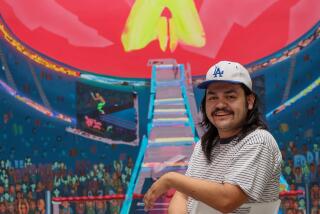Scratching life’s surface
- Share via
There’s the briefest pause, a moment of initial reaction to the unexpected, when senses seem to freeze. It’s the heartbeat of stillness upon being told of a friend’s suicide. It’s watching television one morning and seeing an airplane crash into the World Trade Center. In such flickers of time, lives change.
Those are the moments David Trulli, 43, examines and incorporates into his work as a scratchboard artist. A few years ago, Trulli was a cinematographer, working primarily on low-budget horror films and soft-core porn. He was living in Woodland Hills.
He had always loved Los Angeles, a city he described as a place for dreamers, but he realized that in pursuit of his goals in cinematography and life, some of his dreams had been pushed aside. He and his wife, Lisa, a video editor, decided change was in order.
They sold their home and moved into a high-rise in Los Feliz. Trulli started spending more time working with pinhole cameras and scratchboard art, a process that begins with a white clay-coated board covered with black ink. Fine knives are used to scrape away the ink and create images.
Last year, at his first solo exhibition at Gallery Figueroa in Highland Park, he sold half of his 30 pieces. Buoyed by the success, he decided to take a sabbatical from cinematography and pursue scratchboard art full time. His second solo exhibition, titled “Big City ... Small Stories,” opens Saturday at Gallery 825/LAAA (Los Angeles Art Assn.) Annex at Bergamot Station in Santa Monica. About 14 pieces will be shown, ranging in price from $200 to $3,200.
Much of his work addresses issues of technology, a fascination that began as a child when he attended the 1964 World’s Fair. There is a futuristic, sometimes surreal tone that has been interpreted as haunting and, at times, humorous.
In a piece titled “News,” a man with a Geiger counter, registering the presence of radioactivity, is in a basement listening to the radio. The expression on his face is one of stunned silence.
“I’m not a Luddite,” Trulli says, “but I think it’s important we recognize that technology comes with a price. Sometimes it’s oppressive and seems to bear down on you when you look around and see all the wires, but it can also be beautiful, an enhancement to the landscape.”
The price was high on Sept. 11, 2001. Trulli had awakened early and was listening to Howard Stern on the radio. There was talk of the World Trade Center being on fire, so Trulli turned on CNN. He awakened his wife, and after seeing the second plane crash into the tower, he said to her, “Everything’s going to be different now.”
“I don’t think I understood all that might entail,” he says, “but I think everything is different now. We live with orange alerts. We’re taking our shoes off walking through airports. Airplanes have opened the world up so we can understand other cultures better, but now we understand that they also make great weapons.”
Trulli, who studied film at Loyola Marymount University, had wanted to be a cinematographer since childhood.
Maybe, he says, he was weighted down by passion: “I think that, in a way, my wanting to be a cinematographer from such an early age made it too precious, and I think that’s a bad thing. When things become self-important like that, it blinds us and we don’t look around and understand what we’re doing right now.”
Trulli, who learned about scratchboard art in high school, had long admired the black-and-white photography of Alfred Stieglitz and Usher Fellig, known as Weegee, and some of Trulli’s work is reminiscent of Weegee’s photos taken on the streets of New York in the 1930s.
“Speed Graphic,” for instance, shows a photographer at a crime scene taking pictures of a body behind the Hollywood sign. The dead man was a cinematographer, evidenced by a camera next to him on the ground. “I suppose,” Trulli says, “it’s a bit autobiographical.”
In “Texas,” a woman stands on a farm looking up at lights shooting across the dark sky. Were it a film, the next scene might describe how the lights were created by the space shuttle Columbia as it fell to pieces in a sky both beautiful and tragic, the way technology can be.
It was another flicker of time that captured Trulli’s fascination, the point at which tragedy exploded upon innocence, and suddenly there was no color, only black and white, and the feeling that life and the future somehow had changed.
More to Read
The biggest entertainment stories
Get our big stories about Hollywood, film, television, music, arts, culture and more right in your inbox as soon as they publish.
You may occasionally receive promotional content from the Los Angeles Times.










